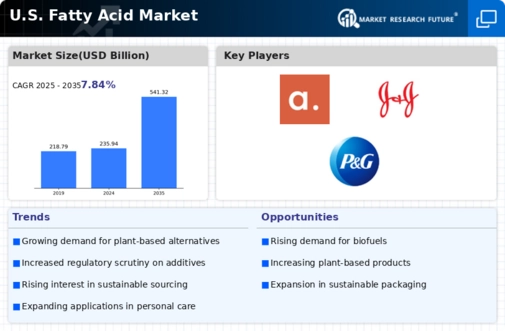Increasing Health Awareness
The growing awareness of health and wellness among consumers appears to be a primary driver for the fatty acid market. As individuals become more informed about the benefits of omega-3 and omega-6 fatty acids, demand for these products is likely to rise. The fatty acid market is witnessing a shift towards healthier dietary choices, with consumers actively seeking supplements and food products enriched with beneficial fatty acids. Reports indicate that the market for omega-3 fatty acids alone is projected to reach approximately $2.5 billion by 2026, reflecting a compound annual growth rate (CAGR) of around 8%. This trend suggests that as health consciousness continues to escalate, the fatty acid market will experience sustained growth, driven by consumer preferences for products that promote heart health and overall well-being.
Expansion of Functional Foods
The increasing popularity of functional foods is significantly influencing the fatty acid market. Consumers are increasingly seeking foods that offer health benefits beyond basic nutrition, and fatty acids play a crucial role in this trend. The fatty acid market is adapting to this demand by incorporating omega fatty acids into various food products, including dairy, snacks, and beverages. According to industry estimates, the functional food market is expected to grow at a CAGR of 7% through 2025, which will likely bolster the fatty acid market as manufacturers innovate to meet consumer expectations. This expansion indicates a promising future for the fatty acid market, as it aligns with the broader trend of health-oriented food consumption.
Rising Demand in Personal Care Products
The personal care and cosmetics sector is increasingly recognizing the value of fatty acids, which is driving growth in the fatty acid market. Fatty acids are known for their moisturizing and skin-conditioning properties, making them essential ingredients in a variety of personal care products. The fatty acid market is benefiting from this trend, as manufacturers incorporate these ingredients into lotions, creams, and hair care products. Market analysis suggests that the personal care segment is projected to account for over 30% of the fatty acid market by 2027, reflecting a growing consumer preference for natural and effective ingredients. This shift indicates that the fatty acid market is likely to expand as personal care brands continue to innovate and respond to consumer demands for quality and efficacy.
Technological Advancements in Production
Technological innovations in the extraction and production of fatty acids are poised to enhance the efficiency and sustainability of the fatty acid market. Advances in processing techniques, such as supercritical fluid extraction and enzymatic methods, are likely to improve yield and reduce waste. The fatty acid market is expected to benefit from these advancements, as they enable manufacturers to produce high-quality fatty acids more sustainably. Furthermore, the integration of biotechnology in fatty acid production may lead to the development of novel fatty acid profiles tailored to specific health benefits. This trend suggests that as technology continues to evolve, the fatty acid market will likely see increased competitiveness and growth opportunities.
Regulatory Support for Nutritional Products
Regulatory frameworks in the United States are increasingly supportive of nutritional products, which is likely to benefit the fatty acid market. Agencies such as the FDA are providing clearer guidelines for the labeling and health claims associated with fatty acids, fostering consumer trust. The fatty acid market is expected to thrive under these regulations, as they encourage transparency and promote the consumption of fatty acid-rich products. Recent initiatives aimed at improving dietary guidelines suggest that the market for fatty acids could expand, particularly in the functional food and dietary supplement sectors. This regulatory support indicates a favorable environment for the fatty acid market, potentially leading to increased product innovation and consumer adoption.














Leave a Comment